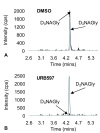The endocannabinoid anandamide is a precursor for the signaling lipid N-arachidonoyl glycine by two distinct pathways
- PMID: 19460156
- PMCID: PMC2689249
- DOI: 10.1186/1471-2091-10-14
The endocannabinoid anandamide is a precursor for the signaling lipid N-arachidonoyl glycine by two distinct pathways
Abstract
Background: N-arachidonoyl glycine (NAGly) is an endogenous signaling lipid with a wide variety of biological activity whose biosynthesis is poorly understood. Two primary biosynthetic pathways have been proposed. One suggests that NAGly is formed via an enzymatically regulated conjugation of arachidonic acid (AA) and glycine. The other suggests that NAGly is an oxidative metabolite of the endogenous cannabinoid, anandamide (AEA), through an alcohol dehydrogenase. Here using both in vitro and in vivo assays measuring metabolites with LC/MS/MS we test the hypothesis that both pathways are present in mammalian cells.
Results: The metabolic products of deuterium-labeled AEA, D4AEA (deuterium on ethanolamine), indicated that NAGly is formed by the oxidation of the ethanolamine creating a D2NAGly product in both RAW 264.7 and C6 glioma cells. Significantly, D4AEA produced a D0NAGly product only in C6 glioma cells suggesting that the hydrolysis of AEA yielded AA that was used preferentially in a conjugation reaction. Addition of the fatty acid amide (FAAH) inhibitor URB 597 blocked the production of D0NAGly in these cells. Incubation with D8AA in C6 glioma cells likewise produced D8NAGly; however, with significantly less efficacy leading to the hypothesis that FAAH-initiated AEA-released AA conjugation with glycine predominates in these cells. Furthermore, the levels of AEA in the brain were significantly increased, whereas those of NAGly were significantly decreased after systemic injection of URB 597 in rats and in FAAH KO mice further supporting a role for FAAH in endogenous NAGly biosynthesis. Incubations of NAGly and recombinant FAAH demonstrated that NAGly is a significantly less efficacious substrate for FAAH with only ~50% hydrolysis at 30 minutes compared to 100% hydrolysis of AEA. Co-incubations of AEA and glycine with recombinant FAAH did not, however, produce NAGly.
Conclusion: These data support the hypothesis that the signaling lipid NAGly is a metabolic product of AEA by both oxidative metabolism of the AEA ethanolamine moiety and through the conjugation of glycine to AA that is released during AEA hydrolysis by FAAH.
Figures









References
-
- Huang SM, Bisogno T, Petros TJ, Chang SY, Zavitsanos PA, Zipkin RE, Sivakumar R, Coop A, Maeda DY, De Petrocellis L, et al. Identification of a new class of molecules, the arachidonyl amino acids, and characterization of one member that inhibits pain. J Biol Chem. 2001;276:42639–42644. doi: 10.1074/jbc.M107351200. - DOI - PubMed
MeSH terms
Substances
LinkOut - more resources
Full Text Sources
Other Literature Sources
Research Materials

